File Info
| Exam | Oracle Datbase 12c SQL |
| Number | 1z0-071 |
| File Name | Oracle.1z0-071.Pass4Sure.2018-11-19.101q.vcex |
| Size | 9 MB |
| Posted | Nov 19, 2018 |
| Download | Oracle.1z0-071.Pass4Sure.2018-11-19.101q.vcex |
How to open VCEX & EXAM Files?
Files with VCEX & EXAM extensions can be opened by ProfExam Simulator.
Coupon: MASTEREXAM
With discount: 20%





Demo Questions
Question 1

Examine the structure of the MEMBERS table:

You execute the SQL statement:
SQL > SELECT member_id, ' ' , first_name, ' ' , last_name "ID FIRSTNAME LASTNAME " FROM members;
What is the outcome?
- It fails because the alias name specified after the column names is invalid.
- It fails because the space specified in single quotation marks after the first two column names is invalid.
- It executes successfully and displays the column details in a single column with only the alias column heading.
- It executes successfully and displays the column details in three separate columns and replaces only the last column heading with the alias.
Correct answer: D
Question 2
You issue the following command to drop the PRODUCTS table:
SQL > DROP TABLE products;
Which three statements are true about the implication of this command? (Choose three.)
- All data along with the table structure is deleted.
- A pending transaction in the session is committed.
- All indexes on the table remain but they are invalidated.
- All views and synonyms on the table remain but they are invalidated.
- All data in the table is deleted but the table structure remains.
Correct answer: ABD
Question 3
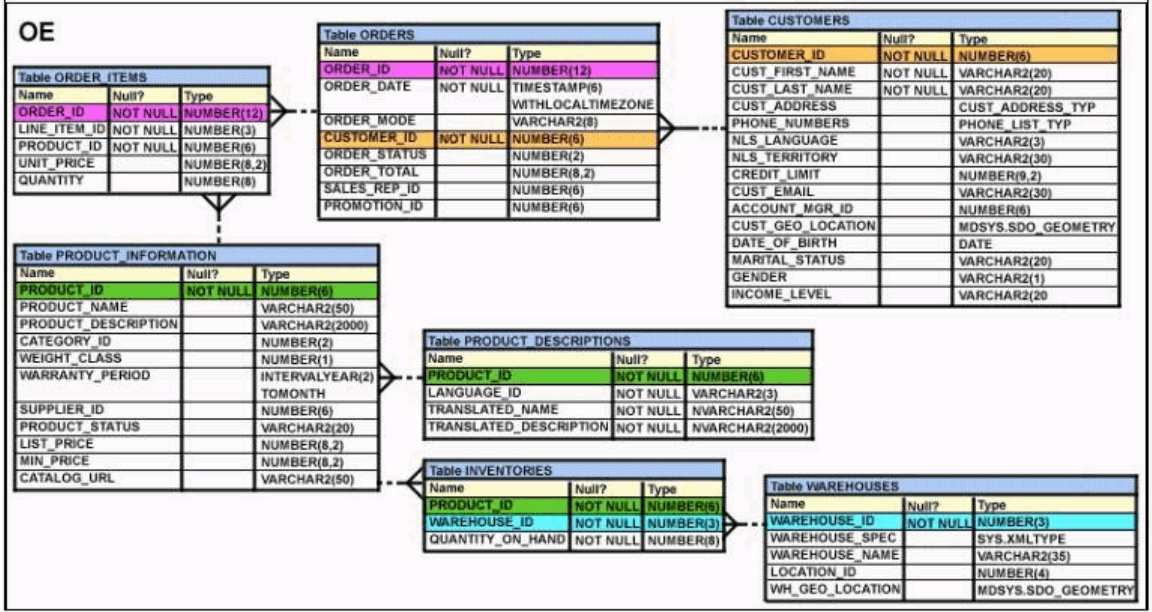
View the Exhibit and examine the structure of ORDERS and ORDER_ITEMS tables.
ORDER_ID is the primary key in the ORDERS table. It is also the foreign key in the ORDER_ITEMS table wherein it is created with the ON DELETE CASCADE option.
Which DELETE statement would execute successfully?

- DELETE orders o, order_items iWHERE o.order_id = i.order_id;
- DELETEFROM ordersWHERE (SELECT order_idFROM order_items);
- DELETE ordersWHERE order_total < 1000;
- DELETE order_idFROM ordersWHERE order_total < 1000;
Correct answer: B
Question 4
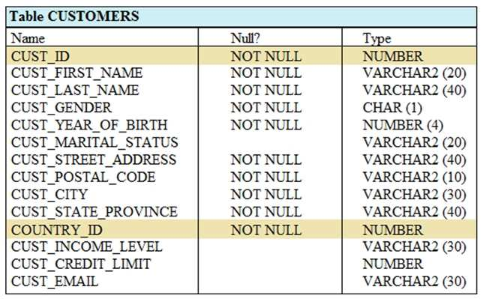
View the Exhibit and examine the structure of CUSTOMERS table.
Using the CUSTOMERS table, you need to generate a report that shows an increase in the credit limit by 15% for all customers. Customers whose credit limit has not been entered should have the message "Not Available" displayed.
Which SQL statement would produce the required result?

- SELECT NVL (TO CHAR(cust_credit_limit * .15), 'Not Available') "NEW CREDIT" FROM customers;
- SELECT TO_CHAR (NVL(cust_credit_limit * .15), 'Not Available') "NEW CREDIT" FROM customers;
- SELECT NVL(cust_credit_limit * .15), 'Not Available') "NEW CREDIT" FROM customers;
- SELECT NVL(cust_credit_limit), 'Not Available') "NEW CREDIT" FROM customers;
Correct answer: A
Explanation:
Question 5
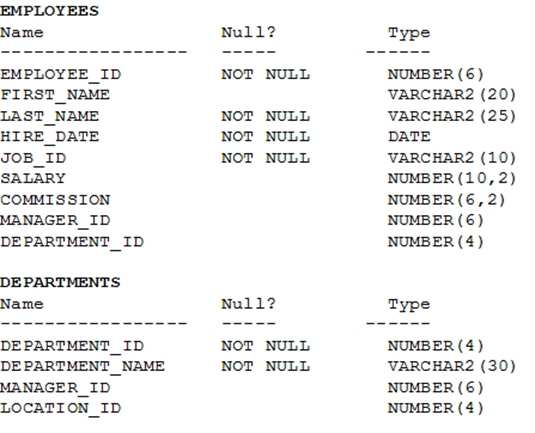
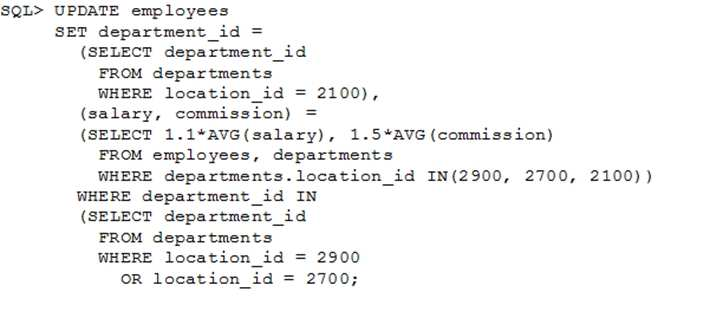
View the exhibit and examine the structures of the EMPLOYEES and DEPARTMENTS tables.

You want to update EMPLOYEES table as follows:
- Update only those employees who work in Boston or Seattle (locations 2900 and 2700).
- Set department_id for these employees to the department_id corresponding to London (location_id 2100).
- Set the employees' salary in location_id 2100 to 1.1 times the average salary of their department.
- Set the employees' commission in location_id 2100 to 1.5 times the average commission of their department.
You issue the following command:

What is outcome?
- It generates an error because multiple columns (SALARY, COMMISSION) cannot be specified together in an UPDATE statement.
- It generates an error because a subquery cannot have a join condition in a UPDATE statement.
- It executes successfully and gives the desired update
- It executes successfully but does not give the desired update
Correct answer: D
Question 6

Evaluate the following two queries:

Which statement is true regarding the above two queries?
- Performance would improve in query 2 only if there are null values in the CUST_CREDIT_LIMIT column.
- There would be no change in performance.
- Performance would degrade in query 2.
- Performance would improve in query 2.
Correct answer: B
Question 7
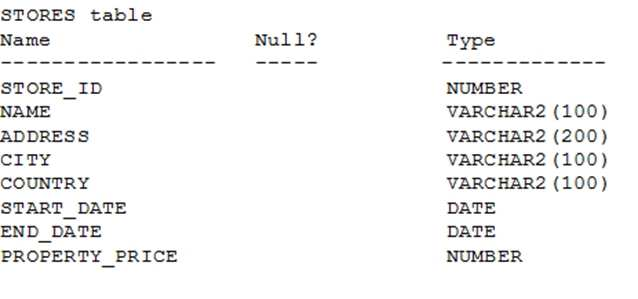
View the exhibit and examine the structure of the STORES table.

You want to display the NAME of the store along with the ADDRESS, START_DATE, PROPERTY_PRICE, and the projected property price, which is 115% of property price.
The stores displayed must have START_DATE in the range of 36 months starting from 01-Jan-2000 and above.
Which SQL statement would get the desired output?
- SELECT name, concat (address| | ','| |city| |', ', country) AS full_address,start_date,property_price, property_price*115/100FROM storesWHERE MONTHS_BETWEEN (start_date, '01-JAN-2000') <=36;
- SELECT name, concat (address| | ','| |city| |', ', country) AS full_address,start_date,property_price, property_price*115/100FROM storesWHERE TO_NUMBER(start_date-TO_DATE('01-JAN-2000','DD-MON-RRRR')) <=36;
- SELECT name, address||','||city||','||country AS full_address,start_date,property_price, property_price*115/100FROM storesWHERE MONTHS_BETWEEN (start_date, TO_DATE('01-JAN-2000','DD-MON-RRRR')) <=36;
- SELECT name, concat (address||','| |city| |', ', country) AS full_address,start_date,property_price, property_price*115/100FROM storesWHERE MONTHS_BETWEEN (start_date, TO_DATE('01-JAN-2000','DD-MON-RRRR')) <=36;
Correct answer: D
Question 8
The BOOKS_TRANSACTIONS table exists in your database.
SQL>SELECT * FROM books_transactions ORDER BY 3;
What is the outcome on execution?
- The execution fails unless the numeral 3 in the ORDER BY clause is replaced by a column name.
- Rows are displayed in the order that they are stored in the table only for the three rows with the lowest values in the key column.
- Rows are displayed in the order that they are stored in the table only for the first three rows.
- Rows are displayed sorted in ascending order of the values in the third column in the table.
Correct answer: D
Question 9

View the exhibit and examine the structure of the EMPLOYEES table.

You want to display all employees and their managers having 100 as the MANAGER_ID. You want the output in two columns: the first column would have the
LAST_NAME of the managers and the second column would have LAST_NAME of the employees.
Which SQL statement would you execute?
- SELECT m.last_name "Manager", e.last_name "Employee"FROM employees m JOIN employees eON m.employee_id = e.manager_idWHERE m.manager_id = 100;
- SELECT m.last_name "Manager", e.last_name "Employee"FROM employees m JOIN employees eON m.employee_id = e.manager_idWHERE e.manager_id = 100;
- SELECT m.last_name "Manager", e.last_name "Employee"FROM employees m JOIN employees eON e.employee_id = m.manager_idWHERE m.manager_id = 100;
- SELECT m.last_name "Manager", e.last_name "Employee"FROM employees m JOIN employees eWHERE m.employee_id = e.manager_id AND e.manager_id = 100
Correct answer: B
Question 10
Which three statements are true about multiple-row subqueries?
- They can contain a subquery within a subquery.
- They can return multiple columns as well as rows.
- They cannot contain a subquery within a subquery.
- They can return only one column but multiple rows.
- They can contain group functions and GROUP BY and HAVING clauses.
- They can contain group functions and the GROUP BY clause, but not the HAVING clause.
Correct answer: ABE

